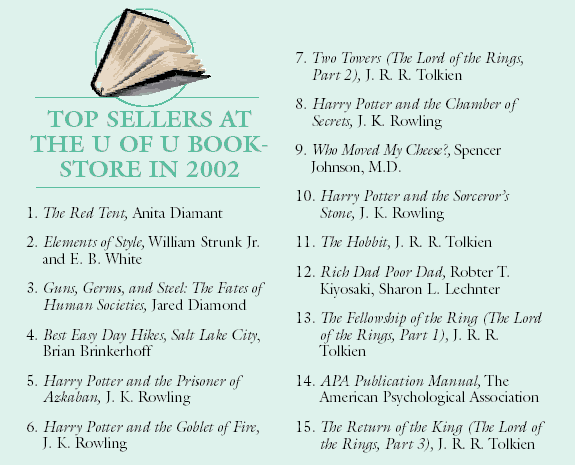|
Recent
Alumni Publications
 |
A Mother’s Book of Well-Being,
by Lisa Groen Braner BS’91, provides
a guide through the first year of motherhood. With a week-by-week
format—52 different chapter titles—and using personal
experiences and journal exercises, Braner details how a mother
must pay attention to her physical, emotional, spiritual, and
intellectual self as she cares for her child. Braner, a mother
who has researched holistic health and motherhood, was a part
of the Hambridge Center, a selective international artists’
and writers’ working residency program, in 2002 (2003;
Red Wheel/Weiser, Boston, MA 02110; paperback; $15.95).
|
 |
In Rogues, Hoboes, and Entrepreneurs: Coping With the
Great Depression, Cy W. Greenhalgh BS’39
MS’42 stimulates the memory of anyone who lived
through the Great Depression and entertains those who know it
only from history. Based on his own experiences of the “rogue”
days of early childhood, he recounts the “adventures and
misadventures” of boys reared in the Tintic Mining District
of Utah, including stories from the 1920s when young boys were
part of rabbit shoots and community celebrations and were fascinated
with cars and finding ways to earn money. The “hobo”
years recount tales of teenagers riding the rails from place
to place looking for work and sharing the satisfying mulligan
stew in the “jungle” (camping place) where each
hobo added what he had to the pot. The “entrepreneur”
chronicles the projects of those who thought it would be better
to try something and fail than to do nothing. After graduating
from the U, Greenhalgh worked for the Bureau of Mines investigating
strategic mineral deposits in Montana, Nevada, and Utah, and
helped to develop a silver mine in Idaho. After WWII, he managed
a paper mill in Old Town, Maine, was executive director of the
Maine Good Roads Association, and editor of its publication,
The Maine Trail. Greenhalgh and his wife live in Sun City West,
Arizona (2000; 1stBooks Library, Bloomington, Ind. 47404; paperback;
$17.10).
|
 |
Following years of geological research and exploration on
opposite sides of the world, two research geologists, Edward
P. Erlich and W. Dan Hausel BS’72 MS’74,
have combined their findings to write Diamond Deposits:
Origin, Exploration, and History of Discovery. From 1951-1962,
Erlich was considered the leading diamond geologist in the former
USSR. He was chief geologist for a team from the Institute of
Arctic Geology that discovered several diamond-bearing kimberlites
(one of the principal host rocks for diamond) in northeastern
Siberia. Erlich immigrated to the U.S. in 1983 and works as
a consulting geologist on various diamond and gold projects
in North America. Hausel, a senior economic geologist and research
geologist with the Wyoming Geological Survey at the University
of Wyoming, has discovered several kimberlites in Wyoming. He
designed exploration programs for U.S. companies and led exploration
efforts to find diamond deposits in other areas of North America
(2002; Society for Mining, Metallurgy and Exploration, Inc.;
Littleton, Colo. 80127; hardcover).
|
 |
Michael Gills PhD’97 describes Why
I Lie: Stories as a “comic novel-in-stories, about
life and death, and the deepening mystery in between.”
The book originated as ten individual stories tied together
by a central character. As a collection, it won the Utah Arts
Council’s 2001 Publication Prize. Gills, who teaches writing
at the U, grew up in Arkansas. The thread through his stories,
set in Southern environs, is Jack, a man whose family “ate
roadkill” and for whom “being poor was a way of
thinking, a mind-set you couldn’t outrun with a suitcase
full of money.” Gills draws the reader into his world
of heartbreak, love, anger, and obstacles, but lets it be known
that through it all, life is good (2002; University of Nevada
Press, Reno, Nev. 89557; paperback; $16.00).
|
 |
Complete with photographs and maps, Uranium Frenzy: Saga
of the Nuclear West, by Raye C. Ringholz BA’49,
is an account of the uranium boom experienced by the Colorado
Plateau region in the 1950s. Spurred by the U.S. government’s
need for uranium to supply its atomic weapons program, and further
encouraged by Charlie Steen’s famous Mi Vida strike in
1952, there was a get-rich-quick frenzy among prospectors, stock
promoters, and buyers from the Four Corners region to Salt Lake
City. The book includes the story of nuclear testing and its
consequences, along with the difficulties posed by extensive
nuclear waste and the legal wrangling over its disposal. Ringholz
has authored several books on the West and has had articles
published in Field and Stream, Westways, and Utah Holiday. She
lives in Park City, Utah (2002; Utah State University Press,
Logan, Utah 84322; paperback; $19.95).
|
 |
In Body and Earth: An Experiential Guide, Andrea
Olsen BA’70 MFA’72 writes, “Body
is our first environment. It is the medium through which we
know the earth.” The book is part workbook and part exploration,
integrating “environmental science, biology, meditation,
and creative expression” to lead the reader toward greater
awareness of the body’s relationship to the earth. It
includes photographs, “farm stories,” and detailed
guides. Olsen is a professor of dance and a faculty member in
the Environmental Studies Program at Middlebury College and
has authored several books on the environment. She is the recipient
of a Fulbright Scholarship to study in New Zealand in spring
2003 (2002; University Press of New England, Lebanon, N.H. 03766;
paperback; $26.00). |
|

